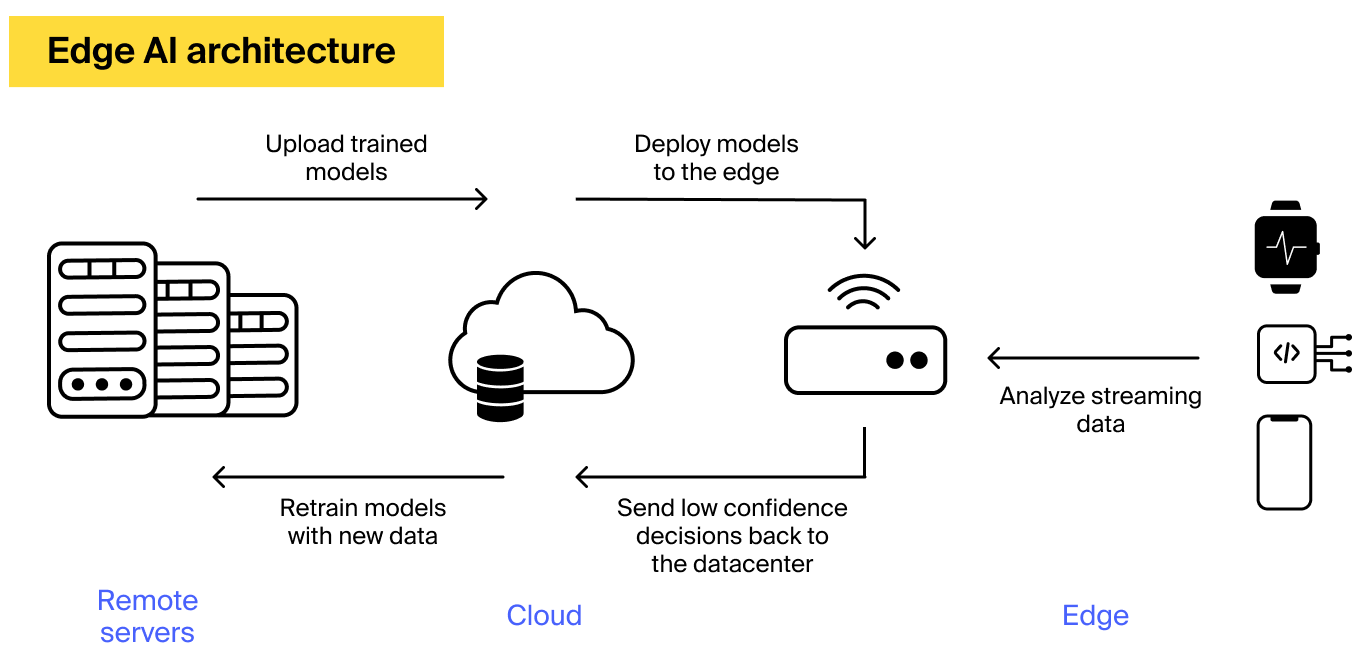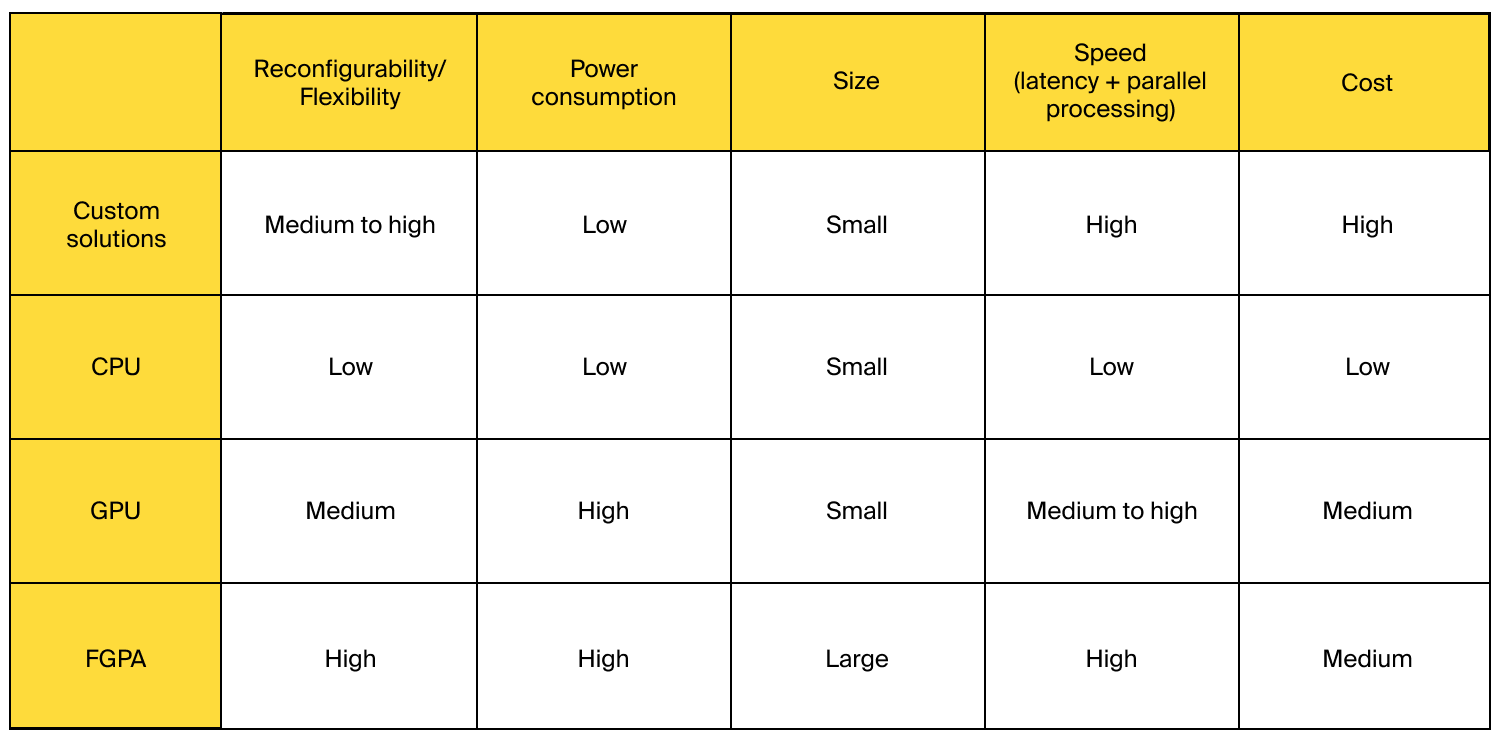Edge AI will help enterprises maintain their edge
While cloud-centric approaches have long been the gold standard for IoT systems, this model is gradually losing favor as AI moves closer to the edge. The reasons for the shift to the edge vary, but the most noticeable ones include high latency and high cloud computing costs. These are particularly acute for large-scale IoT systems.
Still, while artificial intelligence software vendors are extending their offers with developing edge AI systems, businesses are wondering: what is edge AI exactly, how does it work under the hood, and what are the most promising edge AI use cases to pursue? If these are the kind of questions you ask yourself, carry on reading. In the piece below, we spotlight the innards, use cases, benefits, and limitations of edge AI.
What is edge AI, and how does it differ from cloud AI?
A standard IoT architecture can be roughly divided into three components: the things, the gateways, and the cloud. The things stand for all kinds of tools, gadgets, and equipment enhanced with sensors gathering data. Gateways are centralized devices, say, routers, that connect the things to the cloud. Together, the end devices and the gateways make up the edge layer.
As of 2024, approximately 20% of enterprises adopted edge AI, but this number is expected to double in 2025 as the global edge AI market size increases. It was valued at $21.19 billion in 2024, and it’s expected to reach $143.06 billion by 2034, growing at a CAGR of 21.04%.
How does edge AI differ from the cloud?
Edge AI refers to the deployment of AI algorithms closer to the edge of the network, that is, either to connected devices (end nodes) or gateways (edge nodes).
In contrast to the cloud-based approach, where AI algorithms are developed and deployed in the cloud, edge-centric AI systems make decisions in a matter of milliseconds and run at a lower cost.

What are the main benefits of using edge AI?
The key benefits of edge AI include:
-
Lower processing time. Since the data is analyzed locally, there’s no need to send requests to the cloud and wait for responses, which is of utmost importance for time-critical applications, like medical devices or driver assistance systems.
-
Reduced bandwidth and costs. With no need for high-volume sensor data to be sent over to the cloud, edge AI systems require lower bandwidth—used mainly for transferring metadata—and incur lower operational costs.
A large manufacturer relied on a cloud-first system with 50 GPUs to perform anomaly detection using 100 concurrent streams. Hardware costs amounted to $224,000 per site, prohibiting scaling this system to multiple sites. When the manufacturer switched to an edge AI-first approach with quantization techniques, the company could reduce the number of GPU units to just four, with a whopping 92% reduction in costs.
-
Increased security. Processing data locally helps reduce the risks of sensitive information being compromised in the cloud or while in transit.
-
Better reliability. Edge AI continues to run even in the case of network disruptions or when cloud services are temporarily unavailable.
-
Optimized energy consumption. Processing data locally usually takes up less energy than sending the generated data over to the cloud, which helps extend end devices’ battery life.
How does edge AI work under the hood?
Despite a common misbelief, a standard edge-centered AI solution is usually deployed in a hybrid manner. Edge devices make decisions based on streaming data, and a data center—usually cloud-based—is used for revising and retraining the deployed AI models.
So, a basic edge AI architecture typically looks like this:

The process of training deep learning models often runs in the cloud since achieving higher accuracy calls for huge volumes of data and large processing power. Once trained, deep learning models are deployed to an end or an edge device, where they now run autonomously.
If the model encounters a problem, the feedback is sent over to the cloud where retraining starts until the model at the edge is replaced with a new, more accurate one. This feedback loop allows keeping the edge AI solution precise and effective.
A rundown of hardware and software technologies enabling edge AI
A standard edge AI implementation requires hardware and software components.
What hardware is commonly used for edge AI processing?
Depending on the specific edge AI application, there may be several hardware options for performing edge AI processing. The most common ones span CPUs, GPUs, application-specific integrated circuits (ASICs), and field-programmable gate arrays (FPGAs).
-
ASICs enable high processing capability while being energy-efficient, which makes them a good fit for a wide array of edge AI applications
-
CPUs and GPUs can be quite costly, especially when it comes to supporting a large-scale edge solution. Still, they are the go-to option for latency-critical use cases that require data to be processed at lightning speed, such as driverless cars or advanced driver assistance systems.
-
FPGAs provide even better processing power, energy efficiency, and flexibility. The key advantage of FPGAs is that they are programmable, meaning the hardware “follows” software instructions. That allows for more power savings and reconfigurability, as one can simply change the nature of the data flow in the hardware as opposed to hard-coded ASICs, CPUs, and GPUs.
When choosing the optimum hardware option for an edge AI solution, it is important to consider a combination of factors, including reconfigurability, power consumption, size, speed of processing, and costs. Here’s how the popular hardware options compare according to the stated criteria:
What software technologies enable edge AI?
Edge AI software includes the full stack of technologies enabling the deep learning process and allowing AI algorithms to run on edge devices. The edge AI software infrastructure spans storage, data management, data analysis/AI inference, and networking components.
What are some common edge AI use cases across industries?
Companies across sectors are already benefiting from edge AI. Here’s a rundown of the most prominent edge AI applications from different sectors.
Healthcare and bioinformatics
How does edge AI help in analyzing large-scale biological data?
With edge AI, researchers can process enormous datasets in real-time directly at the source—such as microscopes, sensors, or medical devices—without needing to send data to the cloud, reducing latency and maintaining data privacy in this heavily regulated sector. This edge-driven approach also supports early intervention and more responsive research workflows.
For instance, an American-Irish medical device company, Medtronic, partnered with NVIDIA to integrate advanced edge AI technologies into its GI Genius™ Endoscopy Module to support real-time diagnostics during colonoscopy procedures. By processing data directly at the point of collection, GI Genius provides immediate visual markers for potential colorectal lesions, including small, flat polyps that might be missed by the human eye.
Retail
How is edge AI used in retail to improve customer experience?
A positive shopping experience is a major concern for retailers, for it is the factor determining customer retention. With the use of AI-powered analytics, retailers can keep consumers satisfied, making sure they turn into repeat customers.
One of the many edge AI applications aiding retail employees in their daily operations and creating a better customer experience is using edge AI to determine when products need to be replenished and replaced.
Another edge AI application is using computer vision solutions in smart checkout systems that could ultimately free customers from the need to scan their goods at the counter. One example is Amazon’s Just Walk Out technology.
Manufacturing
How does edge AI contribute to smart manufacturing and factory automation?
Manufacturing enterprises, especially those involved in precision manufacturing, need to ensure the accuracy and safety of the production process. By enhancing manufacturing sites with AI, manufacturers can monitor the factory floor for safety and efficiency. For that, they adopt AI applications that carry out factory floor inspections, just like the ones used by Fero Labs and BMW.
Fero Labs, a German software vendor, utilizes edge AI to optimize industrial manufacturing processes. Their software runs machine learning models on existing factory equipment, enabling real-time quality control and predictive maintenance. Using edge AI led to improved product quality, reduced costs, and a significant decrease in CO₂ emissions by an average of 35%.
BMW uses a combination of edge computing and artificial intelligence to get a real-time view of the factory floor. The enterprise gets a clear picture of its assembly line via the smart cameras installed throughout the manufacturing facility.
Automotive
What role does edge AI play in autonomous vehicles and driver assistance systems?
Autonomous cars and advanced driver assistance systems (ADASs) rely on edge AI computing for improved safety, enhanced efficiency, and a lowered risk of accidents.
Autonomous cars are equipped with a variety of sensors that collect information about road conditions, pedestrian locations, light levels, driving conditions, objects around the vehicle, and other factors. Due to security concerns, these large volumes of data need to be processed quickly. Edge AI addresses latency-sensitive monitoring tasks, such as object detection, object tracking, and location awareness.
Consumer electronics
What are the advantages of edge AI in consumer electronics?
Consumer electronics generate lots of data. Processing this data in the cloud comes with its share of challenges, such as high latency and bandwidth usage. To overcome these issues, developers have started turning to edge AI to process the generated data at a higher speed and lower cost.
Edge AI project from ITRex portfolio: AI-powered fitness mirror with a personal coach inside
Project description
Our client envisioned a smart fitness mirror that could bring the experience of a personal strength-training coach into users’ homes. We built a full-length interactive mirror equipped with 3D cameras, IoT sensors, and an AI-powered operating system. Our team designed and trained deep learning models on hundreds of hours of workout footage to deliver dynamic coaching that adjusts to the user’s form. The resulting solution was capable of tracking user movement, analyzing performance, and offering personalized feedback.
Our AI algorithms now deliver accurate feedback after being trained on just two or three short videos—compared to the previous requirement of over 100 hours of footage. This breakthrough in optimization significantly reduces both the engineering effort and cost of scaling our exercise library.
Edge AI
To enable instant feedback and uninterrupted training, we deployed edge AI directly into the mirror’s embedded system. By processing computer vision data and running AI models locally, the mirror could count reps in real time, correct user form, and adapt workout schedules without reliance on cloud connectivity. This edge-native architecture continuously refines user workout experience based on prior sessions, sustaining a seamless, data-driven coaching without compromising responsiveness, privacy, or security.
Security
How does edge AI enhance security applications, like facial recognition?
Facial recognition, human pose estimation, and motion detection are increasingly switching to the edge for faster and more convenient processing.
For security apps with facial recognition capabilities, say, a smart home security system, response time is critical. In traditional, cloud-based systems, camera footage is continuously moved around the network, which affects the solution’s processing speed and operating costs.
A more effective approach is processing video data directly on the security cameras. Since no time is needed to transfer the data to the cloud, the application can be more reliable and responsive.
Edge AI project from ITRex portfolio: AI-powered theft detection software
Project description
To help small retailers operating on a limited budget address a sharp rise in shoplifting and reduce associated financial losses, our team developed an AI-powered monitoring solution for real-time theft detection. Designed to integrate seamlessly with existing IPs and analog CCTV systems, our solution detects suspicious behavior, issues automated alerts, and ensures secure data handling that complies with data privacy standards.
The solution also incorporates the ASCONE protocol to support standardized event communication, enabling structured alert sharing with law enforcement. A user-friendly interface gives staff easy access to live alerts, incident logs, and captured evidence (e.g., criminals’ footage and faceprints).
At the core of the system are custom ML models that we trained on retail theft data using Amazon SageMaker to detect suspicious activity, classify incidents, and deliver real-time alerts via WhatsApp.
Edge AI
To enable edge AI, we used AWS Panorama and Lenovo ThinkEdge SE70 devices that we installed in-store and connected directly to the CCTV system. These devices process video feeds locally in near real-time—within one or two seconds—detecting shoplifting behavior, recognizing faces, and tracking suspicious activities without sending continuous data to the cloud. This approach minimizes latency, reduces bandwidth costs, and ensures faster on-site decision-making.
What are the main barriers or challenges to adopting edge AI?
The major barriers to edge AI adoption are:
-
Limited computing power
Training AI algorithms requires sufficient computing power, which is largely unattainable at the edge. So, the majority of edge-centered applications still contain the cloud part, where AI algorithms are trained and updated.
If you are leaning towards building an edge-centered application that relies less on the cloud, you would need to think over the ways of optimizing on-device data storage (for example, only keeping frames featuring a face in face recognition applications) and the AI training process. -
Security vulnerabilities
Although the decentralized nature of edge applications and limited data movements across the network increase the security features of edge-centered applications, end nodes are still prone to cyberattacks. So, additional security measures are needed to counter security risks.
Machine learning models powering edge solutions, too, can be accessed and tampered with by criminals. Locking them down and treating them as a key asset can help you prevent edge-related security issues.
-
Loss of data
The very nature of the edge implies that the data may not make it to the cloud for storage. End devices may be configured to discard the generated data in order to cut down operating costs or improve system performance. While cloud settings come with a fair share of limitations, the key advantage of those is the fact that all—or almost all—the generated data is stored and can be used for gleaning insights.
If storing data is necessary for a particular use case, we advise using the hybrid approach and relying on the cloud to store and analyze usage and other statistical data.
Embrace the future with edge AI
Edge AI is a transformative force reshaping industries by delivering real-time intelligence, reducing costs, and enhancing security. From healthcare diagnostics to autonomous vehicles and smart manufacturing, businesses across sectors are already reaping the benefits of faster decision-making, optimized operations, and scalable solutions.
The edge is where innovation meets impact.
If you’re ready to explore how edge AI can future-proof your operations and unlock new opportunities, let’s connect. ITRex specializes in tailored edge AI solutions that deliver performance, scalability, and competitive advantage.
FAQs
-
How does edge AI improve data privacy and security compared to cloud AI?
Edge AI processes data locally, reducing the need to transmit sensitive information to the cloud. This minimizes exposure to external networks, lowering the risk of data breaches or unauthorized access.
-
Why do some edge AI solutions use a hybrid approach with the cloud?
A hybrid approach combines the strengths of edge AI and the cloud, and can include fog computing. Edge devices handle real-time processing and immediate decision-making. Fog computing—an intermediate layer between edge and cloud—processes data that is not suitable for the cloud or edge alone and coordinates among multiple edge nodes. The cloud is used for deeper analytics, model training, and centralized data storage. This setup ensures quick responses at the edge, scalable coordination through the fog layer, and powerful system-wide learning in the cloud.
-
Why is edge AI important for latency-sensitive applications?
Edge AI is crucial for scenarios where every millisecond counts—like autonomous vehicles or medical support during surgeries. By processing data locally, edge AI eliminates the delays caused by sending information back and forth to the cloud. This delivers faster responses and greater system reliability.














